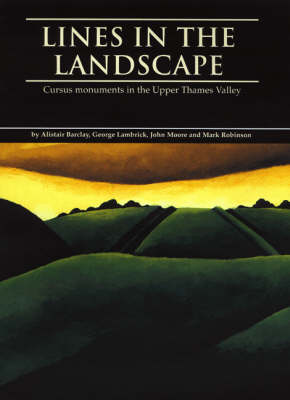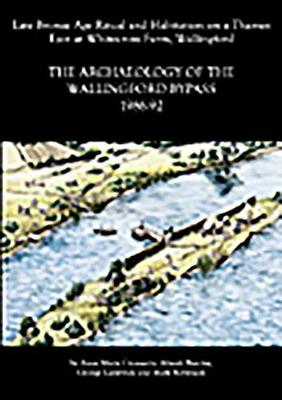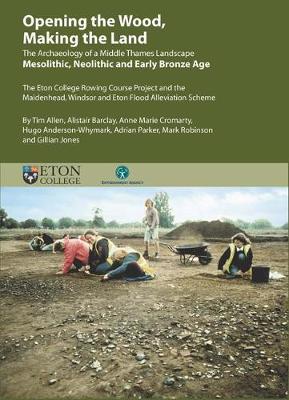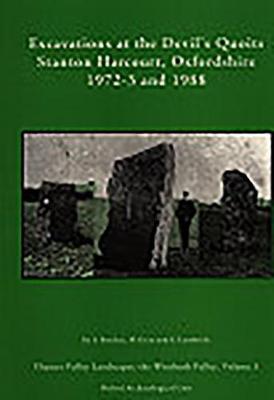Thames Valley Landscapes Monograph
4 primary works • 6 total works
Book 15
Lines in the Landscape
by Alistair Barclay, George Lambrick, John Moore, and Mark Robinson
Published 23 May 2003
The Upper Thames Valley is an important area for prehistoric monuments and has one of the highest concentrations of cursuses, distinctive linear or elongated earthworks, in Britain. In the 1980s the Oxford Archaeological Unit along with the Abingdon Area Archaeological and Historical Society had the opportunity to extensively investigate one of these sites at Drayton. This site has produced many significant results for our present understanding of the date, construction and use of cursus monuments on the lowland river gravels of Britain. This volume reports on the excavations at Drayton, and includes an account of small-scale excavations undertaken at the Lechlade cursus by OAU and Lance and Faith Vatcher. It also provides a gazetteer of known cursus monuments in the Upper Thames Valley.
Book 22
Archaeology of the Wallingford Bypass, 1986-92
by Anne Marie Cromarty, Alistair Barclay, George Lambrick, and Mark Robinson
Published 12 March 2006
The site at Whitecross Farm, including timber structures located on the edge of the eyot, and a substantial midden and occupation deposit has been securely radiocarbon-dated to the late Bronze Age. The late Bronze Age artefact assemblages are suggestive of a high-status site, with a range of domestic and ritual activities represented. The bank of the Grim's Ditch earthwork was found to have preserved evidence of earlier settlement, dating to the Neolithic and Bronze Age, and a sequence of cultivation, including ard marks and 'cord-rig' cultivation ridges. Pottery and radiocarbon analysis dated the earthwork to the end of the late Iron Age or the early Roman period. A multi-period settlement, consisting of pits, a waterhole, postholes, gullies and field systems, was identified at Bradford's Brook, Cholsey. The main periods represented are late Bronze Age and Romano-British, while a small quantity of Saxon pottery indicates limited Saxon activity. A large pit containing late Bronze Age pottery, a cattle skull, waterlogged wood and plant remains, a complete loomweight and flint flakes has been interpreted as a waterhole. A series of radiocarbon dates were obtained for deposits within this feature. All three sites are discussed individually as well as within their local, regional and national contexts. Chapter 7 provides an overall discussion of later Bronze Age themes that have arisen through the excavation and analysis of these sites.
Book 27
The Archaeology of the Gravel Terraces of the Upper and Middle Thames
by George Lambrick, Mark Robinson, and Anne Dodd
Published 12 April 2007
In common with other volumes in the Thames Through Time series, this account of the Thames Valley in the millennium and a half before the Roman conquest seeks to examine change in human society from a thematic point of view. The geographical and chronological framework for this volume is established in Chapters 1 and 2, but thereafter we have tried to get away from the traditional, somewhat artificial pigeon-holes of 'periods' 'ages' 'eras' and 'phases' to look much harder at how change in human society actually works. In a period when the 20th century has come to dominate secondary school history and much popular TV, the notion that the first foundations of modern society can be traced back more than 3000 years may seem a rather surprising proposition. But some fundamental patterns of settlement and landuse, political boundaries, human impact on the environment, and even the specific use and form of a few places can be traced back to late prehistoric times despite millennia of subsequent change - even though otherwise we may now have very little in common with those remote ancestors. Exploring these issues on a thematic basis should help us to gain a better understanding of how human society evolves and also of how people have altered their natural environment, providing a better long term perspective on what we are doing to the planet.
Book 38
Opening the Wood, Making the Land
by Tim Allen, Alistair Barclay, Anne Marie Cromarty, Hugo Anderson-Whymark, Adrian Parker, Mark Robinson, and Gillian Jones
Published 26 November 2013
Excavations at the Eton Rowing Course and along the Maidenhead, Windsor and Eton Flood Alleviation Channel revealed extensive evidence for occupation in an evolving landscape of floodplains and gravel terraces set amidst the shifting channels of the Thames.
The most significant evidence was a series of early Neolithic midden deposits, preserved in hollows left by infilled palaeochannels. These deposits contained dense concentrations of pottery, worked flint, animal bone and other finds, and are put into context by other artefact scatters from the floodplain, pits on the gravel terrace and waterlogged environmental deposits from palaeochannels. Early Mesolithic lakeside occupation, later Mesolithic flint scatters along a former channel of the Thames, pits from the middle and late Neolithic and activity areas of the Beaker and Early Bronze Age, demonstrate longer term changes in patterns of occupation.
The excavations also revealed early, middle and late Neolithic human remains in palaeochannels, middle Neolithic crouched inhumation burials and early Neolithic cremated remains. An oval barrow may have first been cut in the early Neolithic. Other ring ditches date from the late Neolithic/early Bronze Age; one contained a central cremation burial in a Collared Urn together with pyre material and the remains of a bier.
The most significant evidence was a series of early Neolithic midden deposits, preserved in hollows left by infilled palaeochannels. These deposits contained dense concentrations of pottery, worked flint, animal bone and other finds, and are put into context by other artefact scatters from the floodplain, pits on the gravel terrace and waterlogged environmental deposits from palaeochannels. Early Mesolithic lakeside occupation, later Mesolithic flint scatters along a former channel of the Thames, pits from the middle and late Neolithic and activity areas of the Beaker and Early Bronze Age, demonstrate longer term changes in patterns of occupation.
The excavations also revealed early, middle and late Neolithic human remains in palaeochannels, middle Neolithic crouched inhumation burials and early Neolithic cremated remains. An oval barrow may have first been cut in the early Neolithic. Other ring ditches date from the late Neolithic/early Bronze Age; one contained a central cremation burial in a Collared Urn together with pyre material and the remains of a bier.
No. 3.
Excavations at the Devil's Quoits, Stanton Harcourt, 1972-3 and 1988
by Alistair Barclay, Margaret Gray, and George Lambrick
Published 1 December 1995
This volume reports on three seasons of excavation conducted in advance of gravel extraction in 1972, 1973 and 1988 at the Devil's Quoits circle-henge monument near Stanton Harcourt in Oxfordshire. While the stones have gone, evidence has been uncovered for the complete plan. The stratigraphy of the henge ditch (including analysis of sediments and soils) is described. Investigations in the interior uncovered very little pottery, but struck flint and animal bone was found. The construction and significance of the monument is discussed. A gazetteer and review of local pre-Iron Age sites places it in its ancient context, while proposals for its preservation and partial reconstruction as a cultural amenity look to its future.
v. 11
Excavation was undertaken at Barrow Hills, close to Abingdon cuasewayed enclosure, in 1983-1985 prior to development over the Early Bronze Age barrow cemetery. Evidence was recovered on the ceremonial and funerary use of the complex from the early Neolithic to at least the Middle Bronze Age, including the recovery of ring ditches, Neolithic pits, flat graves, pond barrows, and an Early Bronze Age cremation cemetery. Earlier salvage excavations and early reconnaissance of the site are discussed, as well as the wider burial and funerary significance of the site. Post-excavation analysis is described in detail. Its aims were to investigate the structure, chronological sequence and use of the site; the funerary, ceremonial and domestic activity; to place the archaeological finds in a landscape context; to look at artefact deposition and assemblage composition; and to compare the Barrow Hills complex with other sites. Comprehensive and well-illustrated.





